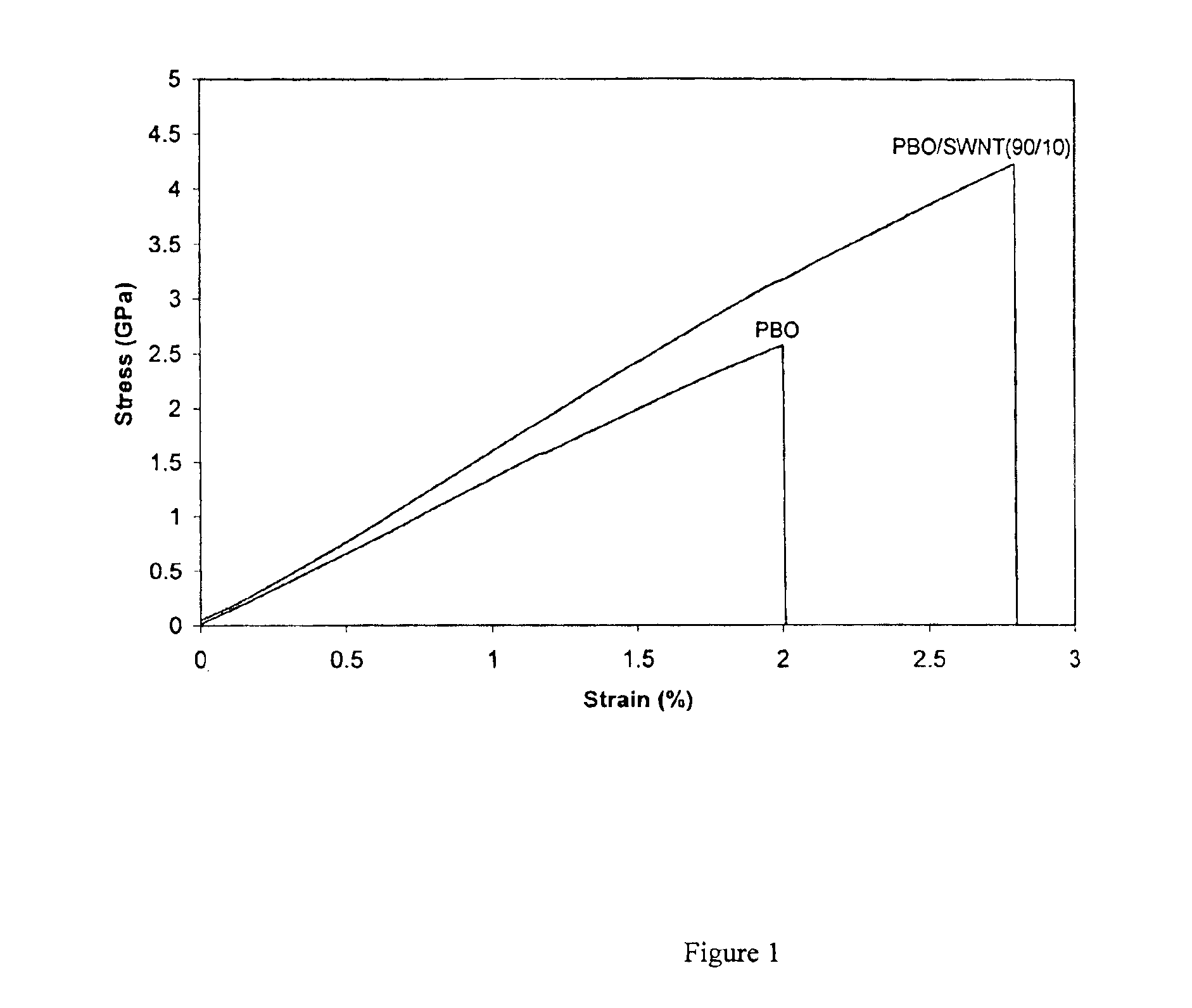Compositions comprising rigid-rod polymers and carbon nanotubes and process for making the same
a technology of carbon nanotubes and rigid rods, which is applied in the direction of transportation and packaging, protective equipment, weapons, etc., can solve the problems of damage to nanotubes, difficult to achieve good dispersion of nanotubes, and even more difficult to disperse single-wall carbon nanotubes, etc., to achieve high modulus and high tensile strength
- Summary
- Abstract
- Description
- Claims
- Application Information
AI Technical Summary
Benefits of technology
Problems solved by technology
Method used
Image
Examples
example i
PBZT / SWNT (95 / 5)
[0026]A composition of 5% single-wall carbon nanotubes (SWNT) and 95% polyphenylenebenzobisthiazole (PBZT) was prepared as follows. Into the bottom of a 250-ml resin flask equipped with a mechanical stirrer, a nitrogen inlet and outlet, was placed 4.904 g (0.02 mol) of 2,5-diamino-1,4-benzenedithiol dihydrochloride, 3.3226 g (0.02 mol) of terephthalic acid, and 20.68 g of phosphoric acid (85%). The resulting mixture was dehydrochlorinated under nitrogen atmosphere at 65° C. for 16 hours. The temperature was then raised to 80° C. and held for 4 hours. 0.26 g of purified single-wall carbon nanotubes (HiPco™ single-wall carbon nanotubes from Carbon Nanotechnologies, Inc., Houston, Tex., purified according to the procedures given in I. W. Chiang, et al., J. Phys. Chem., Vol. 105, 2001, p. 8297) was added to the mixture and heated at 100° C. for 16 hours. The mixture was then cooled the mixture to room temperature. 13.69 g P2O5 was added to the mixture to generate polypho...
example ii
PBZT / MWNT (90 / 10)
[0027]A composition of 10% multi-wall carbon nanotubes (MWNT) and 90% polyphenylenebenzobisthiazole (PBZT) was prepared as follows. Into the bottom of a 250-ml resin flask equipped with a mechanical stirrer, a nitrogen inlet and outlet, was placed 4.904 g (0.02 mol) of 2,5-diamino-1,4-benzenedithiol dihydrochloride, 3.3226 g (0.02 mol) of terephthalic acid, and 20.68 g of phosphoric acid (85%). The resulting mixture was dehydrochlorinated under nitrogen atmosphere at 65° C. for 16 hours. The temperature was then raised to 80° C. and held for 4 hours. 0.52 g of multi-wall carbon nanotubes (Pyrograph PR-24-HT carbon nanofiber grade from Applied Sciences, Inc., Cedarville, Ohio) was added to the mixture. The mixture was heated at 100° C. for 16 hours and then cooled the mixture to room temperature. 13.69 g P2O5 was added to the mixture to generate polyphosphoric acid (77% P2O5). The mixture was stirred for 2 hours at 80° C. and then cooled to room temperature. 12.13 g ...
example iii
PBO / SWNT (95 / 5)
[0028]A composition of 5% single-wall carbon nanotubes (SWNT) and 95% polyphenylenebenzobisoxazole (PBO) was prepared as follows. Into the bottom of a 250-ml resin flask equipped with a mechanical stirrer, a nitrogen inlet and outlet, was place 4.2612 g (0.02 mol) of 1,4-diaminoresorcinol dihydrochloride, 4.0605 g (0.02 mol) of terephthaloyl chloride, and 12.14 g of phosphoric acid (85%). The resulting mixture was dehydrochlorinated under nitrogen atmosphere at 65° C. for 16 hours. The temperature was then raised to 80° C. and held for 4 hours. 0.234 g of purified single-wall carbon nanotubes (HiPco™ single-wall carbon nanotubes from Carbon Nanotechnologies, Inc., Houston, Tex., purified according to the procedures given in I. W. Chiang, et al., J. Phys. Chem., Vol. 105, 2001, p. 8297) was added to the mixture. The mixture was heated at 100° C. for 16 hours and then cooled to room temperature. 8.04 g of P2O5 was added to the mixture to generate polyphosphoric acid (77...
PUM
| Property | Measurement | Unit |
|---|---|---|
| Elongation | aaaaa | aaaaa |
| Elongation | aaaaa | aaaaa |
| Tensile strength | aaaaa | aaaaa |
Abstract
Description
Claims
Application Information
 Login to View More
Login to View More - R&D
- Intellectual Property
- Life Sciences
- Materials
- Tech Scout
- Unparalleled Data Quality
- Higher Quality Content
- 60% Fewer Hallucinations
Browse by: Latest US Patents, China's latest patents, Technical Efficacy Thesaurus, Application Domain, Technology Topic, Popular Technical Reports.
© 2025 PatSnap. All rights reserved.Legal|Privacy policy|Modern Slavery Act Transparency Statement|Sitemap|About US| Contact US: help@patsnap.com



